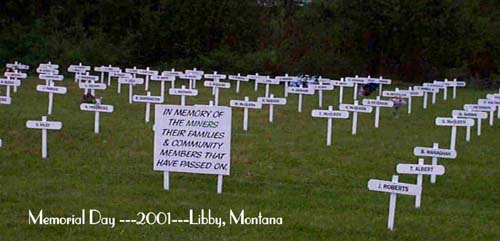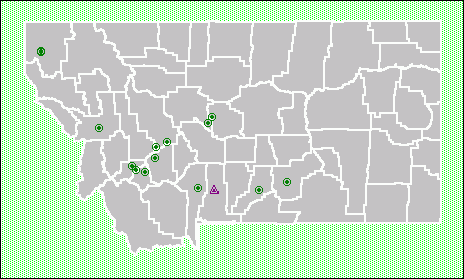|
Death by dust
in Libby 
Photo courtesy of Montana Public Interest
Research Group
Northwestern Montana is home to one of the
nation’s worst environmental disasters in
recent decades. Since the 1960s, over 200
people in the Libby area have died of
asbestos-related lung diseases caused by
dust from a vermiculite mine located seven
miles north of Libby. The problem started to
draw national attention in November of 1999
when an article appeared in The Seattle
Post-Intelligencer.
November and December 1999 . . .
By the time the article was published in
November of 1999, at least 192 people had
died from inhaling microscopic asbestos
fibers from the mine's vermiculite ore.
Furthermore, doctors and Libby area
residents claimed that over 375 others had
been diagnosed with fatal diseases
(mesothelioma, etc.) caused by dust from the
mine. Soon after the article was published,
the EPA sent an Emergency Response team
to Libby. By the end of 1999 the team had
collected nearly 700 samples of the town’s air,
soil, dust, and building insulation. The test
results indicated that many of the town's
homes and businesses contained substantial
quantities of asbestos fibers.
A human tragedy. . .
In 2000 and 2001 the U.S. Agency for Toxic
Substances and Disease Registry screened
over 7,000 current and former Libby residents.
Results showed that nearly 18 percent of
those examined had some form of
asbestos-related lung damage. Among mine
workers, the rate was 48.5 percent. Some of
the victims are family members of miners who
brought the dangerous asbestos fibers home
as dust on their clothing.
Governor uses “silver bullet” . . .
In January 2002 Governor Martz used the State
of Montana's one-time privilege of naming a
site as its highest priority for designation to
the National Superfund Priorities List. With
this, Libby was finally recognized by the
federal government as a hazardous waste site
that needed to be cleaned up. This marked
the beginning of the very expensive and very
controversial efforts to rid the area of asbestos
contamination. Recently the nearby town of
Troy was also included in the project because
health screening there found the same kind of
lung problems found in Libby citizens.
Background . . .
The vermiculite mine operated for a century
before shutting down in 1990. Vermiculite was
once widely used as building insulation and
more recently as a soil conditioner. During
peak production as much as 80 % of the
world's supply of vermiculite came from the
Libby mine. For years, many people in Libby
received vermiculite free of charge from W.R.
Grace (the company that acquired the mine in
1963) and used it liberally in businesses and
homes as insulation, in gardens as a soil
conditioner, and as fill for school running
tracks and football fields as well as other
construction projects.
CLICK HERE to watch a 2.5 minute video about the situation in Libby.
Below: This map shows the
locations of other "superfund sites" in
Montana. Click on the Hot Link to learn about
the individual sites. 
Term: mesothelioma
| 





